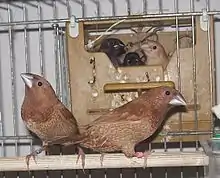Society finch
The society finch (North America) or Bengalese finch (elsewhere), Lonchura striata var. domestica is a popular cage bird which is not found in the wild. The origins are unclear but the bird most likely originated in avicultural practice from Japan or possibly China rather than in Bengal in India.
| Lonchura striata domestica | |
|---|---|
 | |
Domesticated | |
| Scientific classification | |
| Kingdom: | Animalia |
| Phylum: | Chordata |
| Class: | Aves |
| Order: | Passeriformes |
| Family: | Estrildidae |
| Genus: | Lonchura |
| Species: | |
| Subspecies: | L. s. domestica |
| Trinomial name | |
| Lonchura striata domestica Linnaeus, 1758 | |
Evolution and origin
Although the English language literature on aviculture called these birds as Bengali finch, the German aviculturist Karl Russ called them in 1871 as Japanese "Mövchen" (or mew and old word for gull, possibly related to Chinese Mövchen, a pigeon breed named in France and introduced to Germany around the same time for their resemblance to gulls).[1] The birds are members of the estrildid finch family and most authorities consider them a domestic form of the white-rumped munia (known in aviculture as the striated finch) most likely derived from the subspecies Lonchura striata swinhoei[2][3][4] although some have suggested a hybrid origin.[5][6][7]
Behavior
Bengalese finches are well adapted to captivity and the company of humans. They breed well[2] and are good foster parents for other finch-like birds.[8]
While two males may not get along without other company, it has been found the best "pairing" for fostering is to use two males, this works better than either two females or a male and female pairing. Two males will usually accept eggs or even partly grown young without any hesitation.
These birds like to be close together and tend to all roost in one nest if kept in a group. In an aviary they lay eggs and crowd into a single nest, interfering with incubation (which is performed by the female and lasts 16 days) or damaging the eggs. Thus they breed better if kept as single pairs in individual breeding boxes.[2] This sociability is also responsible for their American name of "society finch."
Bengalese finches are quite easy to look after. They are also quite easy to breed provided they are properly sexed. Obtaining a female-male pair can present a difficulty because both sexes look similar. However, it is possible to determine gender by behavior since males tend to display to females. One method to sex Bengalese is to place a single bird in a small cage completely isolated it from its own kind (both sight and hearing) and after several hours then introduce another Bengalese to the cage. If the first bird is a male, it will immediately display to the newcomer. Unfortunately, this does not necessarily mean the introduced bird is a female. But if the first bird does not display it is almost certainly a hen. Also, Society Finches can be housed with other finches including other societies, Zebra Finches, Gouldian Finches, and Spice Finches.
Diet
They are generally given a diet of seeds, such as millets and canary seed, and greens.[2] They will not usually take live-foods, but it has been found they will often accept housefly pupae, which they crack like seeds. This is particularly useful if they are being used to foster species that require a high protein component to be successfully reared.
In research
Society finches have been used extensively in research on imprinting[9] and on bird vocalizations, often comparing the structure of their songs to syntax.[7][10][11]
References
- Svanberg, Ingvar (2008). "Towards a cultural history of the Bengalese Finch (Lonchura domestica)". Der Zoologische Garten. 77 (5–6): 334–344. doi:10.1016/j.zoolgart.2008.05.003.
- Koepff, Christa; Romagnano, April (2001). The Finch Handbook. Barron's Educational Series. pp. 126–127. ISBN 9780764118265. Retrieved 2011-07-14.
- Price, Trevor (2008). Speciation in Birds. Roberts and Co. p. 164. ISBN 978-0-9747077-8-5.
- Warren, Dean M. (2002). Small Animal Care and Management. Cengage Learning. p. 325. ISBN 978-0-7668-1424-0. Retrieved 2011-07-14.
- Alderton, David (1998). The Complete Guide to Bird Care. Howell Book House. p. 24. ISBN 978-0-87605-038-5.
- Rogers, Cyril; Clear, Val (1975). Encyclopedia of Cage and Aviary Birds. Macmillan. p. 117.
- Okanoya, Kazuo (2004). "Song Syntax in Finches: Proximate and Ultimate Analyses". In Slater, Peter. J. B.; et al. (eds.). Advances in the Study of Behavior, Volume 34. Academic Press. pp. 297–346. ISBN 978-0-12-004534-1. Retrieved 2011-07-14.
- Roots, Clive (2007). Domestication. Greenwood Publishing Group. p. 91. ISBN 978-0-313-33987-5. Retrieved 2011-07-14.
- McFarland, David (1999). Animal Behaviour: Psychobiology, Ethology, and Evolution. Longman. p. 369. ISBN 978-0-582-32732-0.
- Hilliard, Austin T.; White, Stephanie (2009). "Possible Precursors of Syntactic Components in Other Species". In Bickerton, Derek; Szathmáry, Eörs (eds.). Biological Foundations and Origin of Syntax. MIT Press. pp. 161–183. ISBN 978-0-262-01356-7. Retrieved 2011-07-14.
- Abe, Kentaro; Watanabe, Dai (2011-06-26). "Songbirds Possess the Spontaneous Ability to Discriminate Syntactic Rules". Nature Neuroscience. 14 (8): 1067–1074. doi:10.1038/nn.2869. PMID 21706017. S2CID 15784076.. Abstract only without fee.
| Wikimedia Commons has media related to Lonchura_striata_(captive). |
External links
- Full description of all known mutations links to varieties are not available.
- Description - National Capital Region Aviaries - website not found
- Bird profile - Drs. Foster & Smith Educational Staff